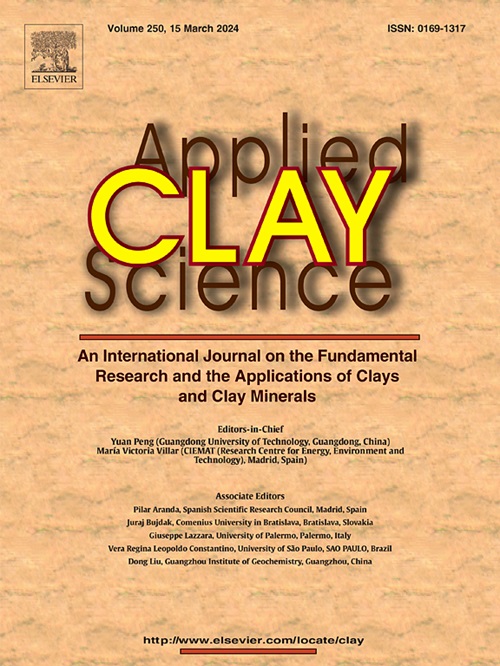Understanding cation exchange capacity measurement for bentonite-cement reactions
IF 5.8
2区 地球科学
Q2 CHEMISTRY, PHYSICAL
引用次数: 0
Abstract
Bentonite barriers in repositories for high-level radioactive waste disposal are expected to interact with Portland cement, which is commonly used during the underground construction of repositories. These reactions occur at a high pH (>12), leading to the formation of XRD-amorphous calcium silicate hydrate (C-S-H) phase and its crystalline analogue, tobermorite, as well as Ca‑carbonate, Ca- and Mg-silicate phases, including zeolites. The cation exchange capacity (CEC) is a key parameter frequently used to evaluate bentonite's ability to swell and adsorb cationic species released from nuclear waste over its lifespan. In addition to being influenced by the residual smectite content, newly formed phases generated during bentonite-cement reactions may also contribute to the bulk CEC. Moreover, the extremely high pH of the reacted material when in contact with water raises questions about the reliability of CEC measurements under such conditions.
In this study, the CEC of both reacted and unreacted bentonite-cement mixtures was tested using hexamminecobalt(III) ([Co(NH3)6]3+) index cation and a spectrophotometric method, under natural pH of the suspension. The extinction of the [Co(NH3)6]3+ solution was almost constant even at high pH, up to 12.5. Fresh, unwashed bentonite-cement mixtures showed higher-than-predicted CEC values due to the strong contribution of smectite edge charges which develop at high pH. Extended washing of the material via dialysis lowered the pH and reduced the excess Ca2+ cations content. After dialysis (up to 4 days), the CEC of bentonite-cement mixtures increased and exceeded the CEC predicted from the smectite content alone. In long-term bentonite-cement reactions (3–36 months, at 80 °C), an initial equilibration occurred rapidly, within days, followed by the slow crystallization of tobermorite at the expense of smectite. However, the large effective dimension of the [Co(NH3)6]3+ cation prevents it from entering the tobermorite structure (as it does to zeolite structures), which results in insignificant contribution of tobermorite to the bulk CEC.
All CEC values measured with the [Co(NH3)6]3+ index cationion reacted bentonite-cement samples were found to be a combination of the exchange by residual smectite and the contribution from new-formed C-S-H phase. The C-S-H phase develops its own surface CEC, which is highly variable and increases as its structural Ca/Si ratio decreases. Soda-soluble silica present in the raw bentonite lowers the Ca/Si ratio in the newly formed C-S-H phase, thereby increasing the CEC of the bulk sample. Also, extensive leaching of Ca2+ cations in an open system during cement maturation decreases the Ca/Si ratio in the newly formed C-S-H phase, enhancing its CEC contribution. In conclusion, CEC measurements on reacted bentonite-cement mixtures must be interpreted with caution as they likely reflect not only the residual smectite content but also the contributions from newly formed C-S-H phases and other reaction products.
了解膨润土-水泥反应的阳离子交换容量测量
高放射性废物处置库中的膨润土屏障预计将与波特兰水泥相互作用,波特兰水泥通常用于地下储存库的建设。这些反应发生在高pH (>12)下,导致形成xrd -无定形水合硅酸钙(C-S-H)相及其晶体类似物tobermorite,以及碳酸钙、钙和镁硅酸盐相,包括沸石。阳离子交换容量(CEC)是评价膨润土在使用寿命期间对核废料释放的阳离子的膨胀和吸附能力的关键参数。除了受残余蒙脱石含量的影响外,膨润土-水泥反应过程中产生的新形成相也可能导致大块CEC。此外,当与水接触时,反应物质的pH值极高,这对这种条件下CEC测量的可靠性提出了质疑。在本研究中,在悬浮液的自然pH值下,使用六考胺钴(III) ([Co(NH3)6]3+)指数阳离子和分光光度法测试了反应和未反应的膨润土-水泥混合物的CEC。在高pH下,[Co(NH3)6]3+溶液的消光几乎是恒定的,可达12.5。新鲜的、未洗涤的膨润土-水泥混合物显示出高于预期的CEC值,这是由于在高pH下产生的蒙脱石边缘电荷的强烈贡献。通过透析延长洗涤材料的时间降低了pH值,减少了过量的Ca2+阳离子含量。透析后(长达4天),膨润土-水泥混合物的CEC增加,超过了仅由蒙脱石含量预测的CEC。在长期的膨润土-水泥反应中(3-36个月,在80°C下),在几天内迅速发生初始平衡,随后是托贝莫来石的缓慢结晶,而蒙脱石的结晶则是缓慢的。然而,[Co(NH3)6]3+阳离子的大有效尺寸阻止了它进入托贝莫来石结构(就像它进入沸石结构一样),这导致托贝莫来石对体积CEC的贡献微不足道。用[Co(NH3)6]3+指数测定的膨润土-水泥样品的CEC值都是残余蒙脱石交换和新形成的C-S-H相贡献的结合。C-S-H相形成自己的表面CEC,其变化很大,随着结构Ca/Si比的降低而增加。原膨润土中存在的钠溶性二氧化硅降低了新形成的C-S-H相中的Ca/Si比,从而提高了整体样品的CEC。此外,在水泥成熟过程中,开放体系中Ca2+阳离子的广泛浸出降低了新形成的C-S-H相中的Ca/Si比,增强了其CEC贡献。总之,对反应的膨润土-水泥混合物的CEC测量必须谨慎解释,因为它们可能不仅反映了残余蒙脱石含量,还反映了新形成的C-S-H相和其他反应产物的贡献。
本文章由计算机程序翻译,如有差异,请以英文原文为准。
求助全文
约1分钟内获得全文
求助全文
来源期刊

Applied Clay Science
地学-矿物学
CiteScore
10.30
自引率
10.70%
发文量
289
审稿时长
39 days
期刊介绍:
Applied Clay Science aims to be an international journal attracting high quality scientific papers on clays and clay minerals, including research papers, reviews, and technical notes. The journal covers typical subjects of Fundamental and Applied Clay Science such as:
• Synthesis and purification
• Structural, crystallographic and mineralogical properties of clays and clay minerals
• Thermal properties of clays and clay minerals
• Physico-chemical properties including i) surface and interface properties; ii) thermodynamic properties; iii) mechanical properties
• Interaction with water, with polar and apolar molecules
• Colloidal properties and rheology
• Adsorption, Intercalation, Ionic exchange
• Genesis and deposits of clay minerals
• Geology and geochemistry of clays
• Modification of clays and clay minerals properties by thermal and physical treatments
• Modification by chemical treatments with organic and inorganic molecules(organoclays, pillared clays)
• Modification by biological microorganisms. etc...
 求助内容:
求助内容: 应助结果提醒方式:
应助结果提醒方式:


